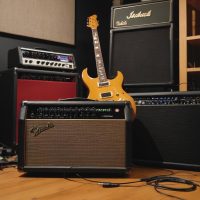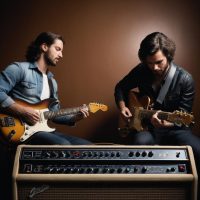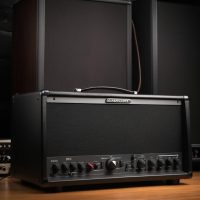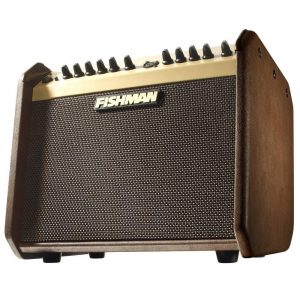Fender 68 Custom Vibrolux Reverb
$1,010.99
Experience the classic Fender tone with modern features in the remarkable 68 Custom Vibrolux Reverb guitar amp.
Compare
Description
As a guitarist, you want an amp that will give you amazing tone, versatility, and power. If that’s what you’re searching for, then you must check out the Fender ’68 Custom Vibrolux Reverb guitar amp! This incredible piece of equipment offers everything you need for incredible sound and performance.
One of the things that makes the Fender ’68 Custom Vibrolux Reverb so desirable is its vintage aesthetic. The retro-style silver grille cloth and the classic ’60s Fender font are a nostalgic touch that is sure to turn heads. But make no mistake, this amp is not just a pretty face. It has a lot of features that will make guitarists salivate.
First, let’s talk about the sound quality. With two 10-inch Celestion speakers, you’ll get a full, rich tone that can go from clean to overdriven effortlessly. The amp’s 35-watt tube power combined with the modern reverb circuitry gives you both classic and modern sounds. Additionally, the foot-switchable vibrato effect can be adjusted to your liking, making the Fender ’68 Custom Vibrolux Reverb capable of delivering everything from vintage surf sounds to modern bluesy rock and everything in between.
The Fender ’68 Custom Vibrolux Reverb guitar amp also comes equipped with additional features that make it all the more desirable. The footswitchable tremolo can add another layer of texture to your sound when you need it, while the bright and normal channels make it easy to adapt to different playing styles.
Another great feature of this amp is the custom-made Schumacher transformers, which provide a clean and consistent sound while being durable enough to last you for years to come.
Whether you’re a gigging musician or a bedroom player, the Fender ’68 Custom Vibrolux Reverb guitar amp is the perfect addition to your setup. With its perfect combination of vintage and modern features, along with a great sound quality, you’ll have all the tools you need to create fantastic music. Don’t wait any longer – get your hands on a Fender ’68 Custom Vibrolux Reverb today!
Fender 68 Custom Vibrolux Reverb properties
| Product name |
68 Custom Vibrolux Reverb |
| Brand |
Fender |
| Type |
Guitar Amplifiers |
| Amplifier Model |
Hybrid Combo |
Frequently Asked Questions:
How does the tube-driven vibrato and reverb circuits of the Fender 68 Custom Vibrolux Reverb differ from its vintage counterparts in terms of tonal characteristics?
The tube-driven vibrato and reverb circuits in the Fender 68 Custom Vibrolux Reverb are updated versions of the classic designs found in vintage Fender amps. These updated circuits offer several tonal improvements over their vintage counterparts:
1. Greater control: The 68 Custom Vibrolux Reverb allows you to adjust the speed, depth, and intensity of the vibrato effect, as well as the reverb level and decay time, giving you greater control over these effects than in vintage Fender amps. Reduced noise: The updated circuits in the 68 Custom Vibrolux Reverb employ modern techniques to reduce noise levels, resulting in a cleaner overall tone. Improved response: The tube-driven design of the vibrato and reverb circuits in the 68 Custom Vibrolux Reverb provides a more natural and responsive feel than some vintage designs, which can sound harsh or artificial at times. Greater versatility: By allowing for greater adjustability and reduced noise, the updated circuits in the 68 Custom Vibrolux Reverb offer a wider range of tonal possibilities, making it suitable for a variety of musical genres and styles.
How does the Fender 68 Custom Vibrolux Reverb's tube complement and tonal shaping circuitry contribute to its unique sound compared to other Fender amplifiers?
The Fender 68 Custom Vibrolux Reverb distinguishes itself from other Fender amplifiers through a combination of its tube complement and tonal shaping circuitry. While many Fender amps utilize the classic 12AX7 preamp tubes, the 68 Custom Vibrolux Reverb features an additional 6CA7 power tube in each channel, providing an increased power output (35 watts per channel) and a fuller, richer sound. This extra tube also allows for greater harmonic content and sustain, especially when playing at lower volumes. In addition to the tube complement, the 68 Custom Vibrolux Reverb boasts a unique tonal shaping circuitry that includes a footswitchable spring reverb and tremolo effects. The reverb is particularly noteworthy for its deep, resonant qualities and extended decay time, which can be adjusted via the Reverb control knob. Meanwhile, the tremolo effect offers both speed and depth controls, allowing players to fine-tune their desired modulation rate and intensity. Overall, these features work in tandem to create a signature tone that is both versatile and distinctive. Whether playing clean or driven passages, the 68 Custom Vibrolux Reverb offers a rich, full-bodied sound that is well-suited for a wide range of musical styles, from classic rock and blues to indie and alternative genres.
What is the wattage of a Fender '68 Custom Vibrolux Reverb guitar amplifier?
The Fender '68 Custom Vibrolux Reverb guitar amplifier has a power output of 22 watts.
What unique features differentiate the Fender 68 Custom Vibrolux Reverb from other amplifier models, particularly in terms of its reverb and vibrato effects?
The Fender 68 Custom Vibrolux Reverb is a guitar amplifier that stands out from other models due to its distinct reverb and vibrato effects. Here are some unique features that differentiate it:
1. Spring Reverb: The Fender 68 Custom Vibrolux Reverb comes equipped with a tube-driven spring reverb unit, which provides rich and natural sounding reverberation. This feature is particularly appealing to players who enjoy using reverb in their playing style as it adds depth and dimension to the overall sound. Tube Vibrato: The amp's vibrato effect is also noteworthy due to its tube-driven design. This means that the signal passes through a triode vacuum tube, resulting in a warmer and more harmonically rich modulation. Additionally, the vibrato has a rate control that allows for slow or fast variations, providing greater versatility. Custom-Voiced EQ: The Fender 68 Custom Vibrolux Reverb boasts custom-voiced EQ controls that are tailored specifically to produce the tonal characteristics of vintage Fender amplifiers. This allows guitarists to achieve a classic, warm sound that is both full-bodied and articulate. External Speaker Jack: Another unique feature is the external speaker jack, which enables players to connect an additional cabinet for greater volume or tonality control. This is particularly useful in live performances where amplified sound levels are required. FX Loop: The amp also features a dedicated effects loop that allows users to integrate their favorite pedals into their signal chain without affecting the core tone of the amplifier. This ensures that the player's desired effect is not compromised by unwanted interference. In summary, the Fender 68 Custom Vibrolux Reverb stands out due to its tube-driven spring reverb and vibrato effects, custom-voiced EQ controls, external speaker jack, and dedicated FX loop. These features make it an attractive choice for guitarists who prioritize tonal richness, versatility, and performance capabilities in their amplifier selection.
What is the exact relationship between the Master Volume and Preamp Gain controls on a Fender 68 Custom Vibrolux Reverb, and how do they interact to produce the desired tone?
**Preamp Gain:**
The Preamp Gain control sets the amount of distortion and overdrive generated by the preamplifier stage. As you turn up the Preamp Gain, you'll introduce more distortion and a warmer, fatter sound. Think of it as "pushing" the preamp harder to produce more gain. However, be careful not to overdo it, as excessive gain can lead to a dirty or fuzzy sound. Master Volume:**
The Master Volume control sets the overall output level of the amplifier. It's essentially a volume pot that controls how much power is sent to the speakers. Turning up the Master Volume will increase the overall loudness of the amp, but it won't affect the tone significantly. Think of it as "controlling" the amount of energy delivered to the speakers. Interplay between Preamp Gain and Master Volume:**
Now, here's where things get interesting. When you turn up the Preamp Gain, you'll start to introduce more distortion into the signal. As a result, the tone becomes warmer and fatter. If you then increase the Master Volume, you'll amplify this distorted signal even further, making it even warmer and fatter. However, if you keep increasing the Preamp Gain beyond a certain point (let's call it the "sweet spot"), the tone will start to degrade into a harsh, fuzzy sound. This is because excessive gain can cause the preamp to clip or distort severely, leading to an unpleasant tone. Here's the key takeaway: The Master Volume control should be used to set the overall level of the amp, while the Preamp Gain control should be used to set the tone and distortion level. When you increase the Preamp Gain, use the Master Volume to fine-tune the overall level to avoid overdriving the preamp. Tone Tips:**
* To get a clean tone with a bit of sparkle, keep the Preamp Gain low (around 3-5 o'clock) and adjust the Master Volume for your desired level. For a warmer, fatter sound, increase the Preamp Gain to around 7-9 o'clock and then use the Master Volume to fine-tune the overall level. Experiment with different combinations of Preamp Gain and Master Volume settings to find the perfect balance for your tone. Remember, these are just guidelines.
Before you buy Fender 68 Custom Vibrolux Reverb










Kritua –
Very good price-performance ratio, a dedicated 12-inch speaker designed in the USA works very well with the tweeter “whistle”. The only drawback of a cosmetic nature: a strange material covering the casing, bright streaks constantly appear on it. Construction disadvantage: you should be a bit careful when placing the speaker in the monitor position – depending on the plugs used, the monitor may rest in this position on the power and signal cables.